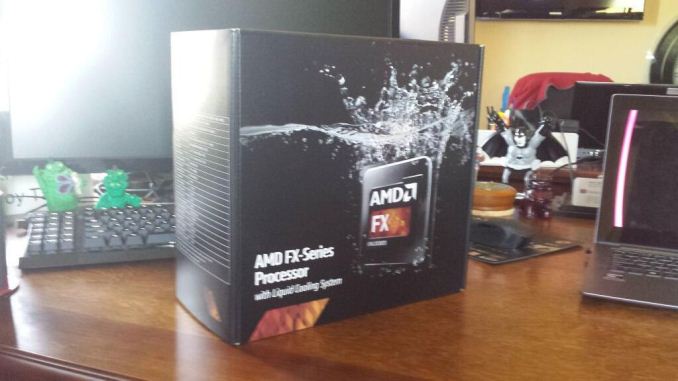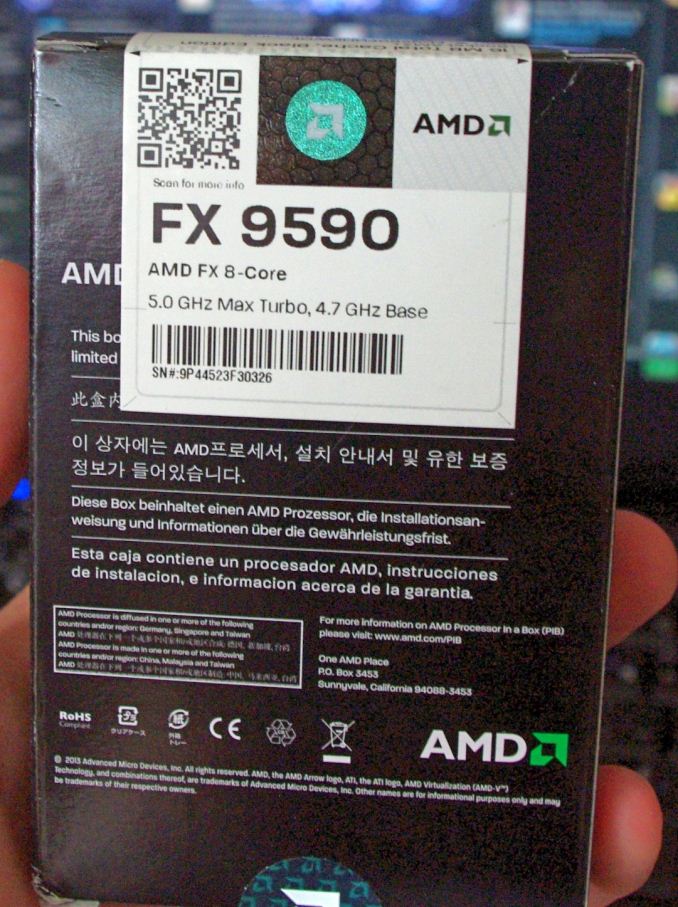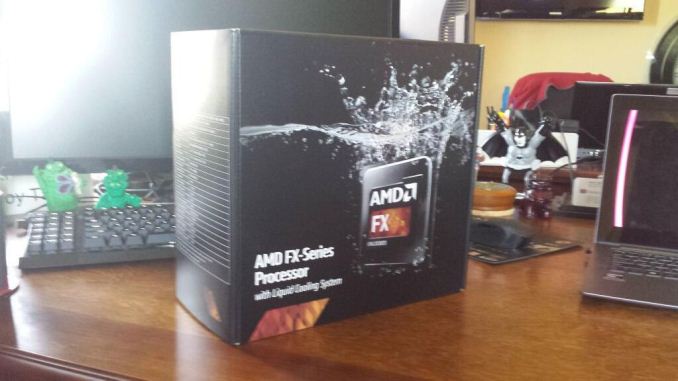AMD’s 5 GHz Turbo CPU in Retail: The FX-9590 and ASRock 990FX Extreme9 Review
by Ian Cutress on August 9, 2014 8:00 AM EST
While AMD’s FX-9590 CPU has been in systems for over a year, it suddenly comes to market as a retail package for end-users to buy with a bundled liquid cooling system. This 220W CPU that has a turbo speed of 5.0 GHz still sits at the top of AMD’s performance stack, despite subsequent improvements in the architecture since. We have decided to grab ASRock’s 990FX Extreme9 and an FX-9590 for a review to see if it still is the AMD performance CPU champion.
Spot the CPU
The story behind AMD’s fastest ever x86 CPUs is slightly odd. Two models, the FX-9590 and FX-9370, were both launched into OEM channels in June 2013. Being an OEM component, the only way to get one was in a pre-built system through a retailer, or through a bulk system integrator that had a model around one of these CPUs. Typically this is a process that is only exhibited with server class processors: from a range of CPUs being produced, only several will be available for end-users at retail because server CPUs usually go through a system builder. At the time, it seemed that AMD concerned that the high TDP of this CPU, at 220W listed, is too much for most cooling setups within a home user system and the best way to get it to consumers would be if a system builder chose the appropriate cooling for them.
As a result of this orientation of sales, AMD did not sample the media with review units. We review an AMD product typically though an AMD sourced sample. It was also noted that the OEM price for the CPU was near $900 for the FX-9590, which seemed like an excruciating amount for what was essentially a good overclocking version of the FX-8350. Several media websites were able to collaborate with system builders in order to get a chance to review the CPU, and AMD was confident in their promotion and handling of the new CPU.
Anecdotally, in my field of vision, the promotion of this CPU was relatively limited. The price was the main factor, resulting in comparative AMD/Intel systems being more power hungry on the AMD side, and substantially more expensive when put up against the latest mainstream i7 at the time. As a result, while some retailers were selling the OEM CPU at full price, some retailers decided to sell their OEM stock with a severe price cut directly to consumers, down from $900 to $390, in order to get rid of units (this is when I picked up our sample).
Due to the OEM nature of these sales to end-users, each CPU had either no warranty with AMD or a limited warranty. For the user interested in a 3-year system cycle without the fear of a bad egg, the OEM route is never a positive one.
AMD subsequently released, relatively silently, a proper package and retail version of the FX processors. It was apparent that this was in response to the OEM sales, with the retailers list ‘heatsink and fan not included’ alongside the specifications.
| AMD FX CPU Comparison | ||||||
|
FX- 4350 |
FX- 6350 |
FX- 8320 |
FX- 8350 |
FX- 9370 |
FX- 9590 |
|
| Release Date |
April 2013 |
October 2012 | October 2012 | October 2012 | June 2013 | June 2013 |
| Modules | 2 | 3 | 4 | |||
| L1 Cache (Code) | 128 KB | 192 KB | 256 KB | |||
| L1 Cache (Data) | 64 KB | 96 KB | 128 KB | |||
| L2 Cache | 4 MB | 6 MB | 8 MB | |||
| L3 Cache | 8 MB | |||||
| TDP | 125W | 220 W | ||||
| Base Frequency | 4200 | 3900 | 3500 | 4000 | 4400 | 4700 |
| Turbo Frequency | 4300 | 4200 | 4000 | 4200 | 4700 | 5000 |
| Core Name | Vishera | |||||
| Microarchitecture | Piledriver | |||||
| Socket | AM3+ | |||||
| Memory Support | DDR3-1866 | |||||
| Price (US) | $140 | $140 | $160 | $190 |
$230 $300 CLC |
$300 $370 CLC |
Since that release, AMD has not upgraded their enthusiast processor line with the latest architecture. The FX line has stayed where it is, perhaps for a number of reasons. One could speculate that releasing the next generation of FX-85xx might put them behind the FX-9590 in performance, or that the fabrication process was not suitable for a quad-module CPU with the new architecture improvements. The FX line for desktops, as far as we know, is staying at 32nm with no improvements.
Now Available
Fast forward twelve months to June 20th 2014 and Roy Taylor, AMD’s VP of Global Channel Sales tweets this innocuous picture:
Speculation was rife as to what this was. Here is a large box for an FX processor with the words ‘with Liquid Cooling System’ underneath. AMD supplied liquid cooling to the media when we reviewed the FX-8350 CPUs, the main CPU that sits underneath the FX-9590 and FX-9370, so there was an expectation that was something new.
On June 26th, the @AMDFX twitter account posted the following, confirming that this was the older FX-9590 but in a retail box with retail cooling:
To celebrate the start of ‘Round of 16’, we’re giving away eleven FX-9590 CPUs! #FXCUP pic.twitter.com/21JRaHdMq8 — AMD FX (@AMDFX) June 26, 2014
The AMD FX Processor page has been updated accordingly, showing the same render of the new box. Here we see that the liquid cooler is supplied by Cooler Master, and uses a wide range PWM fan as part of the package.
Of course, this leaves several questions unanswered: how much, when is it on sale, where is it on sale, and is it still any good? Well for the US at least, it is on sale today from Newegg at $370 with the water cooling kit, or $330 without. NCIX has it listed for CAD$500, although this is currently in ‘back stock’ mode.
The SKU to look for is the FD9590FHHKWOX, which in the UK does not seem to be on the shelves as of yet. Amusingly, when this is typed in to Google, the search engine asked me if I meant FD9590FHHKWOF, the non-CLC version.
This Review
Back when the FX-9590 was originally released alongside the FX-9370, we were unable to secure a sample from AMD and the limited availability made us feel the CPU had a fairly limited scope for testing. However, now the landscape has changed. There has been no new FX CPUs on the market from AMD, and this subsequent release of a retail version piques the interest as to how relevant AMD still sees their high-frequency part. Because I now have a FX-9590 all of my own to test from when the OEM stock was sold, I felt it was worth revisiting to see if it can be considered an investment.
Alongside testing this CPU, the 220W TDP requires a substantial motherboard to match. Due to the age of the platform, the AM3+ socket and the old 990FX chipset, finding a motherboard can be rather tricky. Many of the AM3+ motherboards that were launched were only suited for the FX-8350 processors, which had a 125W TDP. This is yet another reason that AMD wanted the FX-9590 in the hands of system builders who would chose high end motherboards that could cope.
Two of the newest motherboards to be released for 990FX were the ASRock 990FX Killer and the ASRock 990FX Extreme9. We reported the release of the Killer in December 2013, but the Killer is unsuitable here as the specification sheet lists processors up to 125W only. The Extreme9 is ASRock’s high-end AM3+ motherboard, and more suited to the task. Luckily I had requested a sample almost a year ago for some regression testing, so we will be reviewing this motherboard as part of this article.














146 Comments
View All Comments
Budburnicus - Wednesday, January 14, 2015 - link
Umm you KNOW that even stock clocked that the i7-3770K is better and faster in EVERY way, than the 9590 OCed to the max, right?You also know that while you saved, literally, a couple bucks on BUYING your hardware - you are going to spend, comparatively, hundreds of dollars more running it for even 2 years!
Oh then there is the effect that the HUGE power draw has on components - mobos, PSUs, video cards, RAM - because ALL of it gets effected by the insane heat - and certainly ALL of it will be effected if you short your PSU!
And i7-3770K at stock frequencies out performing this POS FX 9590 - is NOT synthetic! That is real world PROVEN speed! NTM, you can EASILY hit 4.7 GHz on any SandyBridge chip - which will not only yield MUCH better performance, but will suck less power and be more reliable as well! And you aren't even going to have to spend that much to buy a good Z77 board and an i5/i7 2500k/2600k (ASRock Z77 Extreme 4 runs right around $100 right now, and is FAR from any budget board, and in fact has more features than ANY FX board that could run this 220W POS!)
So pat yourself on the back, you saved a few bucks on hardware! BUT you completely sacrificed ALL performance, and ANY reasonable upgradability! Also, you will end up paying FAR more than you saved in power costs! (I am sure your power company will thank you for choosing an AMD space heater for a CPU!)
Well on that note, you may save a few bucks on heating, given you live somewhere that gets colder than 50 degrees (Fahrenheit) at some point in the year anyway.
Budburnicus - Wednesday, January 14, 2015 - link
LMAO! Cult - you are such an AMD fanboy NOOB! It is not a cult when PERFORMANCE and EFFICIENCY are the deciding factors!And again, you saved a few bucks when buying your already outdated POS AMD space heater - just wait til that power bill comes!
And if you seriously cannot afford an i5/i7 K processor, even a Sandy or Ivy Bridge, and a Z77 or newer chipset, what the hell good is faster ram and an SSD going to do you? None, unless your workload is entirely composed of highly multi threaded compression/encoding etc.
Have fun with your 220W space heater that has to compete against i3 CPUS! LMFAO!
Budburnicus - Saturday, January 10, 2015 - link
Just another instance of AMD CHUGGING power and crapping performance! Combine this FLOP of a chip (220 W TDP - sweet Jesus! At STOCK) with an R9 290X (300 W TDP, again holy sh*t!) and you are up to over 500 watts TDP!Compare this to an Intel i7-5930K (140 W TDP) paired with a GTX 970 (148 W TDP) and you are ONLY at 288!
Not ONLY that, but the Intel is faster BY FAR at stock speeds, as well the GTX 970, while costing only $30 more - provides ~10%-25% frame rates in basically EVERY benchmark!
I just feel sad for AMD anymore... I am guessing they are too busy with owning ATI and TRYING to compete with SandyBridge and newer Intel products (My i7-2600K beats this FX chip at STOCK speeds in most benchmarks - and basically ALL gaming benchmarks! And that is not even mentioning that the 2600K easily hits 4.4 GHz on any decent mobo/chipset! Then there is the fact that the 2600K is THREE years old, only 95 W TDP - which will NEVER go above 125 even at the 4.7 GHz/102.3 Bclock OC I run!)
AMD should have realized this Chip's Architecture was DOA with the first PileDriver CPUs falling FAR behind the Phenom 2 1100Ts! And even now the 1100Ts generally have better gaming performance!
The REAL question is, WHY? Why have they not dropped this design and brought us a new one? I mean they could try it with limited releases to test it at VERY least, but I hear no word whatsoever about AMD being anywhere close to a completely new chip design!
I was a staunch "AMD Fan-boy" back in the Pentium 4/Athlon XP days! They WERE far better! Also back then ATI could actually compete in gaming!
Now? AMD is only good for budget gaming builds - parts like this FX chip are just about pointless - apart from people who already own a good socket AM3+ mobo. But buying this chip for a breand new build? That would be a HORRIBLE idea! Only the biggest fans of AMD would waste such money and power..
And AMD VideoCards - yes they have better compute performance - so yeah, if you are still GPU mining new Crypto's (Like VertCoin's Lyra2RE Algorithm) - buy an AMD GPU, but 2 or 3 if that is your goal! But even then, apparently the HD 7000 series are STILL the best miners, as they do not consume INSANE amounts of power and do NOT run at a "SAFE 95 deg C" (AMD's quote on R9 290X operating temp!) So, whereas Nvidia and Intel move forward with less power consumption, cooler temps, and better performance where it matters, it REALLY seems AMD is taking steps backwards!
SviatA - Friday, October 30, 2015 - link
So this motherboard suits basically for those who will overclock the processor, graphics and RAM.Honestly, I don't know why would any purchase a AM3+-based motherboard since we have to wait for eight months only to get some AMD Zen processors that are (at least on paper) much better than FX. So, I am thinking about the new motherboard and a new processor. Since Doom 4 will come out next year, will have to get something better than my current configuration, that is based on the ASRock 970 R2.0 (BTW, this is a pretty good MB, have bought it here - http://hardware.nl/asrock/970-extreme3r20.html almost two years ago and happy with it)
Beljim - Saturday, January 9, 2016 - link
Do not buy from Asrock. You will be on your own.
I bought an Extreme9 just before Christmas 2015. Went to raid my 2 Crucial 512gb SSDs and computer would not see them. Called Asrock tech and they told me certain makes of SSDs are not compatible with Extreme9 boards. I explained that SSDs were much older and Asrock board should be backwards compatable. He gave me a short list of drives that were compatible and said I'd have to buy new drives. Asrock took no responsibility and were in no way helpful.
paradonym - Wednesday, February 17, 2016 - link
Where's the described M.2 Slot? Ctrl+F'ing the manual for M.2 doesn't shows up any point.